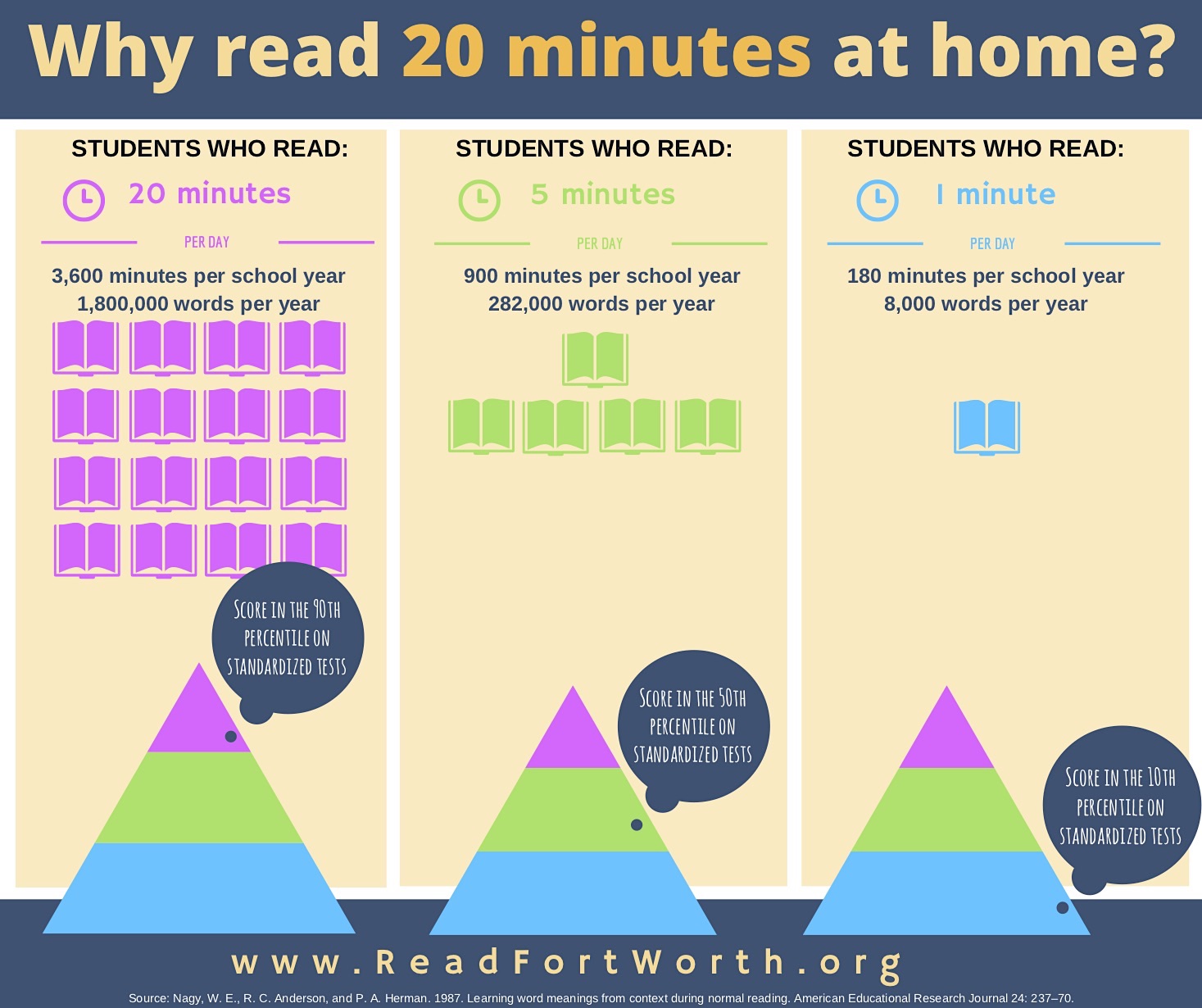I am sure that anyone who is reading this has heard about the connection between 20 minutes of daily reading and academic achievement. There have been countless discussions and research studies about the achievement gap between children who read or are read to, and children who are not.
Some of these studies focus more on the benefits of the expanded vocabulary these students receive. “In four years, an average child in a professional family would accumulate experience with almost 45 million words, an average child in a working-class family 26 million words, and an average child in a welfare family 13 million words” (Hart & Risley, 2003).
 Source (click image to enlarge)
Source (click image to enlarge)
When you work in a high poverty school, these statistics can be not only alarming, but also disturbing. For many schools, this type of information merely cements the fact that some students have advantages that will propel them ahead while others are left staggeringly far behind and there is little that can be done to make lasting real change.
Luckily for me (and our K-4 students), Harlan Elementary doesn’t share this outlook.
Last year, we started a focus on combating the “gap” – the discrepancies in reading and vocabulary acquisition among our kids. We decided to stop making excuses and start coming up with action steps that could make a difference for all our students.
Some of the steps we’ve taken
We began a “Zip-Locked on Reading” program and sent books in baggies home with our students each night. Each baggie included a picture of the graphic about the importance of reading 20 minutes per night.
Our student council has also taken turns reading to younger students in the mornings before class begins. We started a #CaughtReading challenge and have asked parents to send in pictures of their child reading alone or with them at home. We post these pictures on our social media as a way for students to encourage one another to read.
We have also held several parent engagement meetings and provided information, books, and encouragement for our parents to promote reading at home. These are just a few examples of ways we are seeing a shift in our student reading levels.
School Counselor Amanda Green
The “Goodnight, Harlan” videos project
 This year, our counselor read about another way we might encourage reading at home that we have adapted as our own. We call it , “Goodnight, Harlan.”
This year, our counselor read about another way we might encourage reading at home that we have adapted as our own. We call it , “Goodnight, Harlan.”
We are encouraging every adult in our building – administrators, teachers, and every staff member – to participate by making a video reading a picture book. Our goal is to help our students see we all value reading and want to be a part of their reading – even when they are at home. In addition, we believe that our students will develop an expanded vocabulary from the exposure to a variety of stories.
Each reader is choosing his or her own book from our growing collection of videos. Dr. Casteel, the building principal, debuted the “Goodnight, Harlan” readings with the book, “Go Away, Big, Green Monster.”
Principal Thomas Casteel
This supports an understanding that he is not only the lead learner, but also the lead reader in our building. We have created a link on our school web page to past readings. Students may go back at any time and watch any of the readings they may have missed when they were posted on Facebook or Twitter.
Each staff member selects a favorite story or chooses one that they just think our students might enjoy. While we are reading, we model talking about what we are reading, just as we would if we were reading to our own children or grandchildren. We hope this will have an added benefit of modeling ways to read aloud for our parents.
Instructional Partner Melanie Harris
Our results so far!
It has been wonderful to walk down the hall or into a classroom and hear a child say, “I watched you read to me last night.” We might not be able to ensure that every student has the benefit of a home filled with books and rich conversation. We might not be able to convince every parent about the importance of reading at home each night. However, we can find a way to bring the opportunity for reading home with them each night and believe that we can make a difference – even if it is One Child, One Parent, One Bedtime Story at a time.
Jill Edwards
Jill Edwards is assistant principal at Harlan Elementary in the Florence City (AL) Schools. Her 16-year education career is highlighted in this post. Follow her further adventures on Twitter @jillae0823. You can read an interesting earlier ABPC Blog post by Jill here: “FMS Teachers Use Common Planning Time to Look at Student Work.”


0 Comments on "Harlan Elementary Attacks the Reading Gap with “Goodnight, Harlan” Bedtime Stories and Other Strategies"